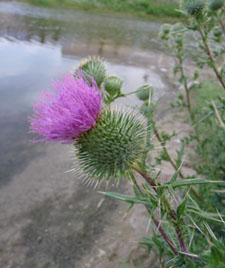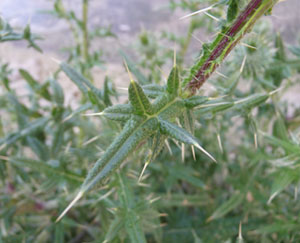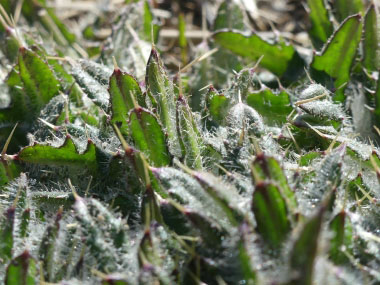





To support our efforts please browse our store (books with health benefits, etc.).
Bull thistles have earned the title of noxious or invasive in many areas. They are distinguished from all other thistles by the covering of short, sharp prickles on the upper, dark green surface of the leaf blade. It is these prickles that make the surface very harsh to the touch. Like many other plants, the bull thistle grows a rosette in its first year and blooms in its second year of life.
Distinguishing Features
The bull thistle is a biennially growing plant. The main stem of this wild edible is firm and thorny. This plant bears leaves that end in extended, very sharp thorns and are beige in colour. This thistle produces a lot of seeds that have small feathers and are fixed to the base by means of a ring until they mature. The roots of this plant are taproots. They are thin and run deep and can develop several smaller lateral roots.
Flowers
Bull thistle flower heads are purple and measure 3.5 to 5 cm in diameter, 2.5 to 5 cm long and are usually solitary. There are clusters of them that grow at the ends of shoots and branches. Flowers are subtended by narrow, spine-tipped bracts.
 Fields
of Nutrition has medicinal benefits and vitamin/mineral content of Bull Thistle.
Fields
of Nutrition has medicinal benefits and vitamin/mineral content of Bull Thistle.
Leaves
Bull thistle leaves are alternate, pinnately cut, (lance-shaped) and they have rough, bristly hairs on top and hairy underneath. They can grow anywhere from 7.5 to 30 cm long. Lobes on leaves are tipped with stout spines. Mature leaves grow down the stem beyond their bases, causing the stalk to be ‘winged’ and prickly, lobed leaf-like structures.
Height
The bull thistle can grow up to 1.5 metres in height.
Habitat
Bull thistle is a weed that can grow in a wide range of environments but prefers disturbed areas. It tends to grow best in soils with intermediate moisture although it will grow in dry and wet soils. It likes pastures, edges of woods, waste places, fence lines and roadsides. Its rosettes are occasionally troublesome in lawns and gardens.
Edible Parts
Bull thistle root can be eaten and is best used when mixed with other vegetables. Young flower stems can be cooked and young leaves can be eaten in a salad or tossed into a sauté. The taste is somewhat bland but the prickles MUST BE removed from the leaves before the leaves can be eaten! The flower buds can be cooked and used like globe artichokes, but they are smaller. Bull thistle seeds can be roasted. (Bull thistle root is rich in inulin.)
Other Name
Cotton Thistle.
Winter Survival Food Handbook

PDF Plant Magazines
Types of Wild Food
Geographic Zones Seasons
Disclaimer
EdibleWildFood.com is informational in nature. While we strive to be 100% accurate, it is solely up to the reader to ensure proper plant identification. Some wild plants are poisonous or can have serious adverse health effects.
We are not health professionals, medical doctors, nor are we nutritionists. It is up to the reader to verify nutritional information and health benefits with qualified professionals for all edible plants listed in this web site. Please click here for more information.
Why Edible Wild Food?
- Food costs are rising
- Free, wild food is readily abundant
- Wild food adds nutrition to your diet
- Wild food can help treat various medical conditions







